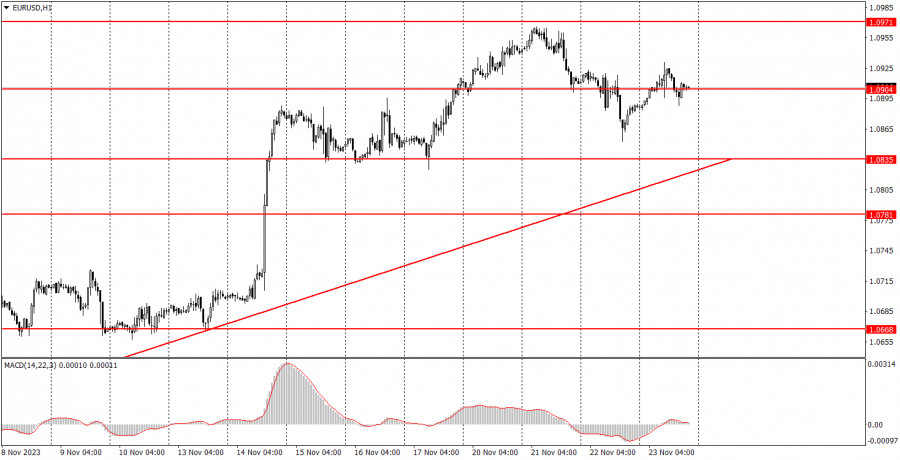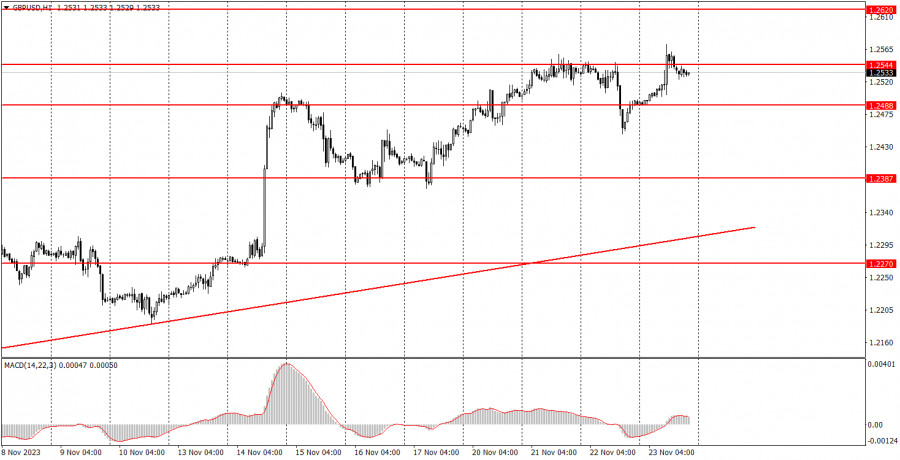

For Friday, there will be four macroeconomic events. The purchasing manager indexes (PMI) data will be released in the U.S., and Germany will publish the final estimate for its Q3 GDP report. Recall that we are interested in the composite indices, while the Services and Manufacturing PMIs are also particularly significant. But the challenge lies in the fact that in the U.S., business activity indices according to ISM are also published, which are considered more important and significant. The market usually overlooks the S&P indices. As for the GDP report in Germany, the market has practically ignored data on GDP in both the U.S. and the EU, so there is nearly no chance of seeing a market reaction to the German report.
Analysis of fundamental events:Among the fundamental events on Friday, we can highlight speeches by European Central Bank President Christine Lagarde and Vice President Luis de Guindos. These events are important enough on paper, but we have repeatedly mentioned that we shouldn't expect loud statements from ECB officials. The ECB's policy for the next six months is clear as day. It is unlikely that anything has changed in the last week.

On Friday, there will be several interesting events, but all of them have extremely low chances of moving the market. Most likely, we will see around 50 pips of volatility for the euro and around 70 pips for the pound. Of course, some market reaction to the events mentioned above should occur, but who is interested in a 20-pip move?
Basic rules of a trading system:1) Signal strength is determined by the time taken for its formation (either a bounce or level breach). A shorter formation time indicates a stronger signal.
2) If two or more trades around a certain level are initiated based on false signals, subsequent signals from that level should be disregarded.
3) In a flat market, any currency pair can produce multiple false signals or none at all. In any case, the flat trend is not the best condition for trading.
4) Trading activities are confined between the onset of the European session and mid-way through the U.S. session, post which all open trades should be manually closed.
5) On the 30-minute timeframe, trades based on MACD signals are only advisable amidst substantial volatility and an established trend, confirmed either by a trend line or trend channel.
6) If two levels lie closely together (ranging from 5 to 15 pips apart), they should be considered as a support or resistance zone.
How to read charts:Support and Resistance price levels can serve as targets when buying or selling. You can place Take Profit levels near them.
Red lines represent channels or trend lines, depicting the current market trend and indicating the preferable trading direction.
The MACD(14,22,3) indicator, encompassing both the histogram and signal line, acts as an auxiliary tool and can also be used as a signal source.
Significant speeches and reports (always noted in the news calendar) can profoundly influence the price dynamics. Hence, trading during their release calls for heightened caution. It may be reasonable to exit the market to prevent abrupt price reversals against the prevailing trend.
Beginning traders should always remember that not every trade will yield profit. Establishing a clear strategy coupled with sound money management is the cornerstone of sustained trading success.